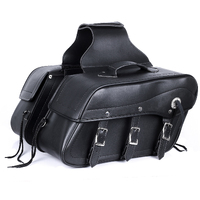
BGA Fender 3 Buckle Leather Motorcycle Saddlebags
$199.00
or 4 payments of $49.75 with
 Info
Info
Welcome to one of life's greatest adventures. Whether you ride a motorcycle as a pleasure seeker or commuter, riding on two wheels is a great experience designed to give you years of enjoyment and satisfaction.
Whether you are a seasoned rider looking to replace or upgrade an existing helmet or you're just starting off, our Helmet Buying Guide is designed to take some of the heavy lifting out of finding the right helmet for you. Besides, if you're busy doing research that means you're not on your bike enjoying the freedom of an open road and countryside.
Do you plan to ride a lot or commute to work?
If riding is your everyday transportation or you take weekly road trips, higher end helmets may prove to be more comfortable and offer better dynamics and reduced wind noise. Versatility and comfort is important for touring, traveling long distance or riding for extended periods of time.
Are you riding with a group?
Many bikers join riding groups and if you haven't already done so eventually you'll pal around with others and find group riding enhances the overall experience. One key element to group riding is communication and you'll want a helmet with built in communication provisions. You can install most blue tooth systems in just about any helmet with a few exceptions.
Helmet Shell Material
What the helmet is made of influences a number of factors including weight, comfort and safety rating. Polycarbonate, Fiberglass composite and Carbon Fiber compose most helmets with a layer of expanded polystyrene (EPS) foam.
Helmets typically range in weight from 1300 to 1800 grams. The key to weight is a properly fitting helmet so the weight is distributed evenly around your head and shoulders. If the center of gravity is off a lighter helmet can feel heavier and strain your neck. Modular helmets often weigh more than a Full Face because of the apparatus installed to flip up the visor.
Comfort features
Today's helmets offer a lot of technological advances. Features like integrated sunshade, wind reduction styling and communication provisions all serve to enhance the riding experience.
A properly fitted helmet can play a major role in the outcome of an accident. The first step in finding a motorcycle helmet is determining your head size.
A helmet that is too big will not protect your head as well as a properly fitted helmet. Follow these steps:
Price is often reflected in the materials used and the number of features. In short, a more expensive helmet generally offers better protection, comfort and technology but that doesn't mean you can't find a quality helmet for a reasonable price.
Subscribe to the Bikers Gear Australia mailing list to receive updates on new arrivals, special offers and other discount information